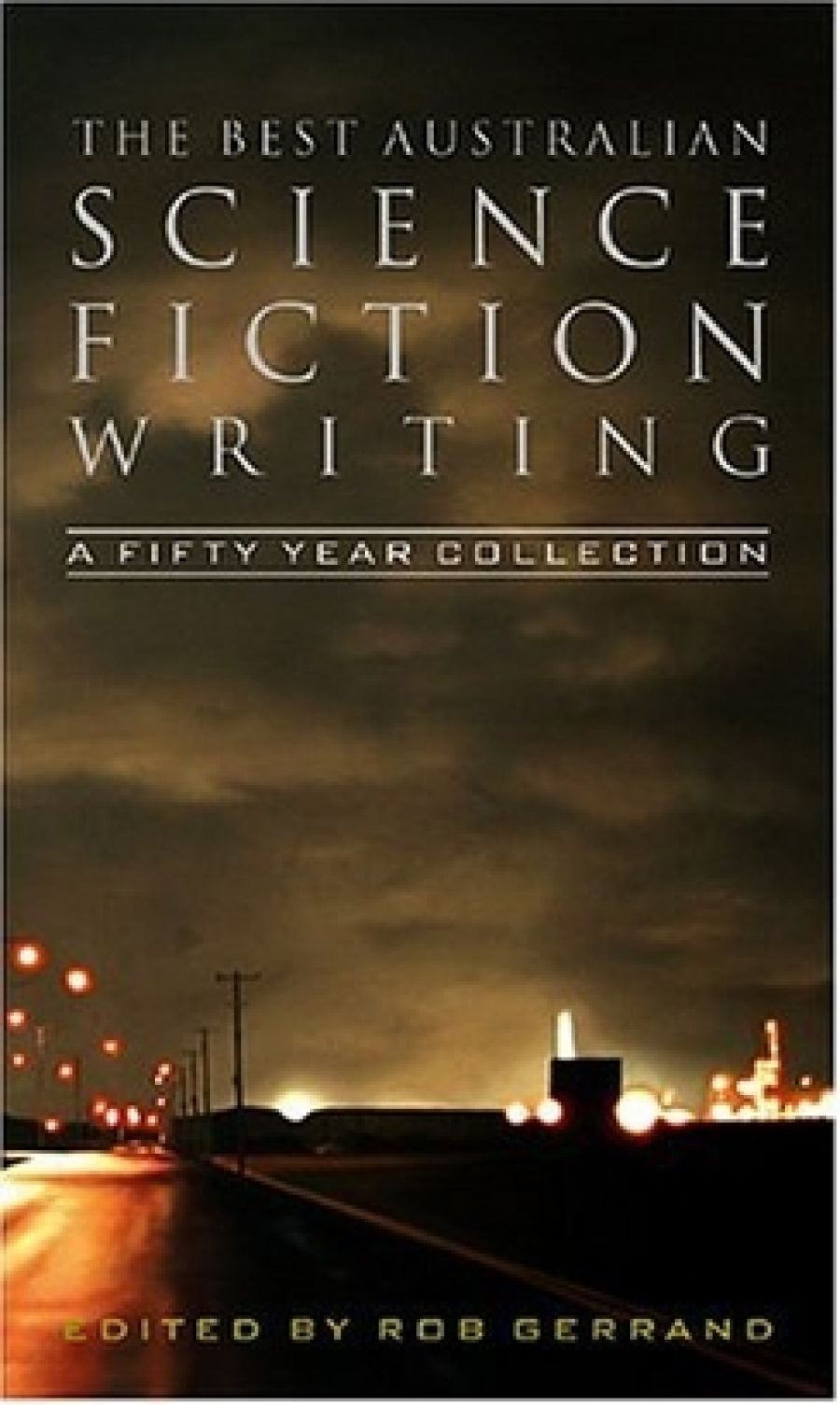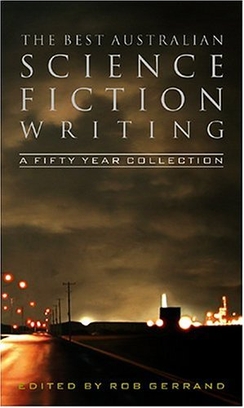
- Free Article: No
- Contents Category: Fiction
- Review Article: Yes
- Article Title: The angel thing
- Online Only: No
- Custom Highlight Text:
Writers of contemporary fiction are often novelists only; writers of heroic fantasy, a genre that increasingly overlaps with science fiction, tend to write very long novels only. Science fiction is different; the short story has been important for most of its practitioners, though it sets taxing formal problems when the writer has to cram the details of an alternative or future world into a short compass. The first of the stories in this big anthology of Australian science fiction was published in 1955, the most recent in 2001, so it offers a good sense of the path the genre has traced.
- Book 1 Title: The Best Australian Science Fiction Writing
- Book 1 Subtitle: A fifty-year collection
- Book 1 Biblio: Black Inc., $39.95 pb, 635 pp
- Book 1 Cover Small (400 x 600):

- Book 1 Cover (800 x 1200):

One thing that emerges clearly is how much more rich and interesting Australian science fiction has become since the late 1960s. The transition is spectacular. It happens with three stories: Damien Broderick’s ‘The Final Weapon’ (1969), Lee Harding’s ‘Dancing Gerontius’ (1969) and Michael Wilding’s ‘The Man of Slow Feeling’ (1970). Each opens with the main character in an institution, struck down by a grim condition that affects mind as well as body, and matters have deteriorated still further by the end of the story. Bleak as these stories are, the arrival of sheer, if suffering, physicality on the scene of Australian science fiction, accompanied by complex relations between mind and body – a newly uncertain identity in the point-of-view character – signals a new departure. We are dealing with divided subjects in a world whose pressures are strange yet oppressively close: in the bedroom; in the old people’s home. In spite of the bleakness of these stories, it is hard to avoid the upbeat term ‘coming of age’, especially when one encounters Peter Carey’s ‘The Chance’ (1979) and takes stock of the sense of place – detailed, quirky, nostalgic, tough – and the story’s investigation of the nature of love, love’s relations to ‘rage’, how it can be love of an other, an alien almost.
Looking forward from this breakthrough, the most striking development that follows is the entrance of women writers: fabulations marked by dry wit and enjoyment of the quirks of language or jargon: Rosaleen Love’s ‘The Total Devotion Machine’ (1989), Lucy Sussex’s ‘Red Ochre’ (1990), or intense renditions and transformations of the domestic. These include Philippa Maddern’s ‘Inhabiting the Interspaces’ (1979), in which a young woman makes a secret life and routine for herself in the nocturnal spaces of an office building, like a female Crusoe in the city (a parable of female autonomy and vulnerability), Kafkaesque for all its quiet style; and two stories about the predicaments of young women who see too much (Petrina Smith’s ‘Angel Thing’, 1995) or feel too much (Margo Lanagan’s ‘The Boy Who Didn’t Yearn’, 2000). These two stories are particularly welcome; the others I have mentioned have already been anthologised. The sober and conscientious feminism of Sean McMullen’s ‘Tower of Wings’ (2001) can be added, though McMullen has explored matters of gender with a slyer wit elsewhere.
What’s science fictional about all this? Where are the rockets, mutants and aliens that feature in thousands of stories? In fact many of these stories can be read as re-enchantments of common science fiction tropes: stripped of dubious scientific trappings, the mutant reveals its power as metaphor for the humanly other and special, as in Lanagan’s story, or Smith’s (the ‘angel’ here is the victim of a botched attempt to make a cyborg), or is made, in Sussex’s story, to figure in a reconnection of Aborigines and the powerful creatures of the Dreamtime.
They may also suggest certain formal advantages in fabulation, or simply in intense concentration on the consequences of a clear premise, because it is difficult to fit the details of future societies and technologies into the necessary concision of the short story. Jack Wodhams’s ‘There Is a Crooked Man’ (1967) attacks this problem with humour, and the result is a kind of compendium or paroxysm of mutations, body swaps, crimes and scams, enabled by the clumsy miracles of genetic engineering, interwoven frantically in multiple plots. George Turner’s ‘In a Petri Dish Upstairs’ (1978), a much-anthologised story, exhibits the difficulties in a more serious form. So many innovations, nuances of future behaviour, and cultural developments are crammed into the plot, many by way of quick asides, that the author comes across as a kind of know-all. At the other extreme is Randal Flynn’s ‘The Paradigm’ (1979), a story with a relatively conventional totalitarian set-up, in science fiction terms, but powerfully about an author who does not know what he is going to write when he sets out to write.
The more common recourse is to rely on the reader’s knowledge of the conventions of the genre. The sensational (time travel, or the visit of a wise alien from the Galactic Government to a seedy fairground) can be seen, deadpan, as unremarkable, as in David Lake’s ‘Re-deem the Time’ (1978) or David Rome’s ‘Parky’ (1961), since the reader has read many a more sensational version of the trope. The result is a joke, more or less witty, but not much more. The more ambitious solution to this paradox – that a genre centred on the amazing and the not-yet is deeply reliant on the already-written – is to be found in Sean Williams’s ‘The Soap Bubble’ (1994), but also, much earlier, in Martin Loran’s ‘The Case of the Perjured Planet’ (1967). These stories both posit that we shape our actions in terms not merely of the narratives we already know but of the narrative clichés we know and love: detective stories, in the case of Loran, the soapie element in Star Trek and such, in the case of Williams. Williams’s very clever twist is to have the aliens themselves understand how humans are ‘psychodramatic’, but to have them miss the fact that humans don’t always take their psychodramas literally.
Do these stories give us science fiction with a distinctly Australian quality? Certainly, the earlier stories, up to that moment of transition in the late 1960s, are competent contributions to an international (Anglo-American) genre; and science fiction is, in important ways, constitutively cosmopolitan anyway. Yet the change perhaps involves more a discovery of new dimensions of the modern and postmodern, and the invention of ways of adapting the genre to express them. The situation is still open. I found the most successful stories to be the fables (tightly organised, emotionally concentrated), but many of the more recent stories in Rob Gerrand’s anthology are quite different. They show the current cross-fertilisation of science fiction and fantasy: exuberant, exotic, even lush. ‘The Sheik poured coffee into tiny, exquisite cups’ (from Janeen Webb and Jack Dann’s ‘Niagara Falling’, 1997) – I’m not sure how unseriously to take a sentence like that. Perhaps Australianness in these stories is less a presence and more something an author can mobilise and evoke, as in the first sentence of Sussex’s ‘Red Ochre’: ‘Fogarty’s Animal Show had just crossed that invisible border up north beyond which people are strange.’ Similar, poignant and familiar is the scene in Smith’s story in which the narrator and her mother take the angel thing to the local baths.
A couple of quibbles. Gerrand reprints Greg Egan’s ‘The Caress’ (1990), but is this often-anthologised story, with its reliance on the trope of the cruel artist–billionaire, really the best representative of the work of this formidably intelligent and challenging writer? Likewise, Terry Dowling’s ‘He Tried to Catch the Light’ (1998), ambitious as it is (god, love, death and the evils of public relations) lacks the wonderful combination of the baroque and the sparse that is to be found in his Tom Rynosseros stories.


Comments powered by CComment